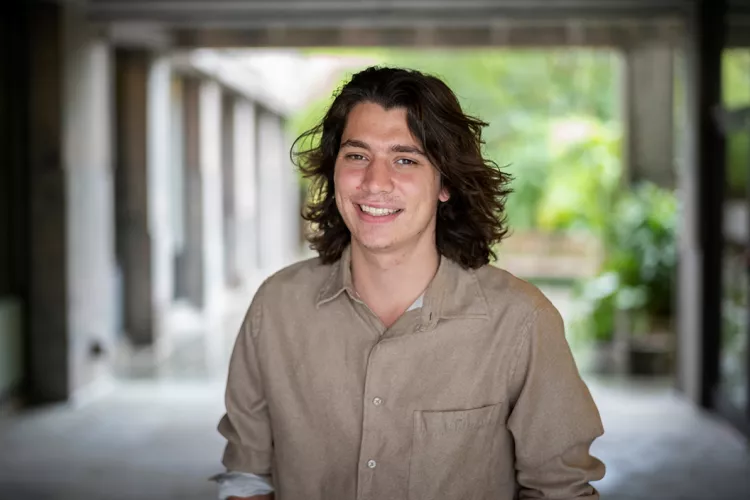Re-Chewable Energy: Engineering Capstone Could Turn Food Waste into Fuel

It turns out that composting isn’t the only way to responsibly dispose of your banana peels and week-old leftovers. An anaerobic food digester can turn food waste into methane biogas of a quality more than high enough to use for cooking your next meal — and maybe in a few years, college and university dining facilities could be doing just that, thanks to a project started by Charlie Cole ’21.
Cole began thinking more about the need for reliable energy sources after studying at the University of Cape Town in South Africa last spring with the College’s joint Macalester-Pomona-Swarthmore Consortium Program, “Globalization, Environment & Society,” where he experienced weekly, scheduled electricity blackouts for the first time.
In America, “we’ve never had to think about energy. The lights always turn on; the hospitals always have power,” says Cole, an environmental engineering and religion major from Oak Park, Ill. “I think that’s a really important part of what our energy system needs to look like, having things that can generate energy whenever, 24 hours a day, at every second.”
He took an interest in biogas because it can be stored and used at any time, unlike other popular forms of renewable energy.
“Solar and wind power both create variable sources of energy, which means it’s inconsistent when you can actually use electricity,” Cole says. “Biogas you can burn whenever you need to. It can be still, it can be cloudy, it can be nighttime, it can be daytime — biogas will always burn.”
Cole received authorization to live on campus this fall so that he could begin building a small-scale anaerobic digester with his capstone adviser, Professor of Engineering Carr Everbach. The pair aim to begin feeding it with a small percentage of Sharples waste in early spring.
“If we’re making biogas at the end of the year, that’s a win,” Cole says.
Cole first learned about anaerobic food digesters after his sophomore year, when he spent the summer testing and optimizing the performance of the food digester at Clarkson University. He was there to participate in the National Science Foundation-funded Research Experience for Undergrads. Nearly two years later, he still emails his adviser from that summer, Clarkson Professor of Civil & Environmental Engineering Stefan Grimberg, for guidance and tips as he designs and builds his own.
To get the digester running, Cole will build up a microbe population in the anaerobic chamber with regular feedings of about 10 to 20 pounds of food waste every day. This colony of microbes feeds on food waste that enters an anaerobic chamber. Due to the lack of oxygen, the decomposition process releases methane, rather than carbon dioxide, as a byproduct. The digester then collects this methane as gas and passes it through several purification columns so that burning it doesn’t release harmful carcinogens into the air.
A greenhouse gas 28 times more potent than CO2, methane has gotten a bad rap — it’s surprisingly well-known that the methane produced by cows contributes to global warming. However, as Cole often explains to skeptics, the food digester process doesn’t release methane into the atmosphere; it only catches and stores the gas before it will be burned, releasing the same amount of carbon dioxide as if the food were composted.
When Cole completes the project in the spring, students will be able to see not only the digester through a two-story window in the front of Singer Hall, but also the purification of the gas in a clear bubbling column. Cole received extra funding for this and other design elements from the Halpern Family Foundation Engineering Design Fund, which was established in 2007 by Michael Halpern ’68 and Christine Grant ’69.
And maybe in a few years, Swarthmore, like Clarkson, could have a large-scale digester. Because the College burns its own gas onsite — hence the smoke stack by the Matchbox — the project lays the groundwork for a larger system that could use campus waste to replace a portion of that gas with biogas in the future.



